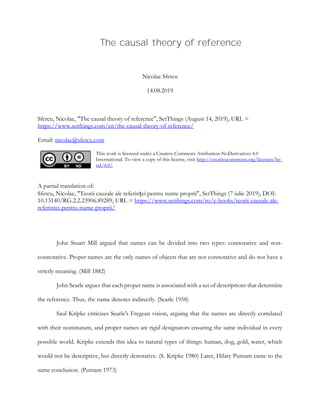
The causal theory of reference
- 1. The causal theory of reference Nicolae Sfetcu 14.08.2019 Sfetcu, Nicolae, "The causal theory of reference", SetThings (August 14, 2019), URL = https://www.setthings.com/en/the-causal-theory-of-reference/ Email: nicolae@sfetcu.com This work is licensed under a Creative Commons Attribution-NoDerivatives 4.0 International. To view a copy of this license, visit http://creativecommons.org/licenses/by- nd/4.0/. A partial translation of: Sfetcu, Nicolae, "Teorii cauzale ale referinței pentru nume proprii", SetThings (7 iulie 2019), DOI: 10.13140/RG.2.2.23906.89289, URL = https://www.setthings.com/ro/e-books/teorii-cauzale-ale- referintei-pentru-nume-proprii/ John Stuart Mill argued that names can be divided into two types: connotative and non- connotative. Proper names are the only names of objects that are not connotative and do not have a strictly meaning. (Mill 1882) John Searle argues that each proper name is associated with a set of descriptions that determine the reference. Thus, the name denotes indirectly. (Searle 1958) Saul Kripke criticizes Searle's Fregean vision, arguing that the names are directly correlated with their nominatum, and proper names are rigid designators ensuring the same individual in every possible world. Kripke extends this idea to natural types of things: human, dog, gold, water, which would not be descriptive, but directly denotative. (S. Kripke 1980) Later, Hilary Putnam came to the same conclusion. (Putnam 1973)
- 2. Gareth Evans presents his own vision, distinguishing two types of descriptive theories: a theory of what a speaker denotes by a name, and a theory of what a name denotes itself. (Evans and Altham 1973) Later, Searle returns by defending himself against Kripke's critics, introducing the concepts of "intentional content" and "intentional state." In their definitions and arguments, philosophers have used the concept of possible worlds, with the real world as one of many possible worlds. Each proposition is either true or false, in every possible world. Thus, we have true propositions (those that are true in the real world), false (which are false in the real world), possible (those that are true in at least one possible world), impossible (or necessarily false propositions, those that are not true in any possible world), necessarily true (those that are true in all possible worlds) and contingents (those that are true in some possible worlds and false in others). Saul Kripke introduced for the first time a semantics of modal logic, in which a possible statement is true in at least one possible world, and a necessary statement is true in all possible worlds. Descriptive theories have tried to eliminate certain logical contradictions if the names were considered definite descriptions. Kripke rejected the validity of these descriptive theories by arguing that no unique description of identity is needed, identifying descriptions can be used even if the reference has not been correctly identified, and a description (as opposed to a name) cannot function as a rigid indicator. Subsequently, descriptive theories extended this idea of the disguised definite descriptions to a set of descriptions or a weighted average of these descriptions. Causal theories of reference describe how terms acquire specific references (especially logical terms, proper names, and natural terms) based on evidence. In the case of names, a causal theory of reference assumes that 1) the referent of the name is fixed by an original designation (called by Saul
- 3. Kripke "initial baptism"), after which the name becomes a rigid designator of that object; 2) the name is subsequently transmitted by communication through a causal chain. Saul Kripke and Hilary Putnam proposed the extension of causal theory to natural terms. In general, causal theories of reference can be classified into causal-historical theories of reference (original version), represented in particular by Keith Donnellan (Donnellan 1972) and Saul Kripke, (S. A. Kripke 1979) with the idea of a causal-historical chain, (Cumming 2016) and the causal- descriptive theories of reference, (Psillos 1999) developed by David Lewis, (Lewis 1984) on the idea that there must be a minimal descriptive system as intermediate to the causal relations between the speaker and the object. The main criticism of the causal theory was that the communication between the different users of the name is not enough explained. Louis deRosset highlighted the main differences between descriptive and causal-historical theories: (deRosset 2011) Descriptive theories Causal-historical theories Personal information helps to determine the name reference It does not matter the information, only the historical position determines the name reference You can't be massively misinformed about the name referrer You can be massively misinformed about the name referrer You can't really be under-informed about the name referent - such situations are deference cases You can be under-informed about the name referrer
- 4. If you are under-informed but still use a name for a specific individual, you need to think about your own words If you are under-informed but still use a name for a specific individual, you do not need to think about your own words Bibliography , edited by Edward N. Zalta, Fall 2016. Metaphysics Research Lab, Stanford University. https://plato.stanford.edu/archives/fall2016/entries/names/. - http://www.uvm.edu/~lderosse/courses/nnn/caus_theor.pdf. , edited by Donald Davidson and Gilbert Harman, 356 79. Synthese Library. Dordrecht: Springer Netherlands. https://doi.org/10.1007/978-94-010-2557-7_10. 47: 187 225. https://www.jstor.org/stable/4106912. Kripke, Saul. 1980. . Harvard University Press. , edited by A. Margalit, 239 83. Reidel. 62 (3): 221 236. Mi https://ebooks.adelaide.edu.au/m/mill/john_stuart/system_of_logic/. Psillos, Stathis. 1999. . Routledge. 70 (19): 699
